- In October 2025, NRGV launched Asset Vault, backed by $300M in non-dilutive financing from U.S.-based infrastructure firm Orion Infrastructure Capital (OIC), marking a pivotal step in the company’s evolution. The platform targets $100-$150M in recurring EBITDA within four years across 1.5 GW of projects with $1B total CAPEX. The current portfolio includes four projects (341 MW), two operational, and two in development, targeting $40M in annual EBITDA by 2027.
- The company also has a project backlog of approximately $300M from third-party deployments, expected to be recognized as revenue in 2025–2026.
- NRGV is trading at 12x forward EBITDA vs the sector average of 16x, a 24% discount. Q3 results are due next week, and we anticipate a significant sequential increase in revenue from the current backlog.
Risks
- Tariffs: U.S. tariffs on Chinese lithium-ion imports may raise costs
- Policy: Changes in green energy incentives could reduce demand
- Credit: Customer or partner defaults may affect revenue
- Compliance: Projects must meet all regulations and permits
- Financing: High upfront costs require funding
Price and Volume (1-year)



* Energy Vault Holdings has paid FRC a fee for research coverage and distribution of reports. See last page for other important disclosures, rating, and risk definitions. All figures in US$ unless otherwise specified.
Company Overview
NRGV develops and deploys grid-scale energy storage solutions for renewable energy applications, serving utilities, independent power producers (IPPs), and large industrial customers.
Founded in 2017, NRGV went public in 2021, and now serves utilities, IPPs, and large industrial customers
Founded in 2017, the company initially focused on R&D to commercialize its proprietary gravity-based energy storage technology. Starting in 2022, NRGV diversified into battery and hybrid energy storage systems, generating revenue by installing these solutions for third-party projects. By 2025, after completing several projects, the company shifted its strategy toward owning and operating storage assets rather than solely deploying systems for third parties. This transition enables recurring, predictable revenue from long-term energy and power sales agreements, replacing its earlier one-time, project-based revenue model.
Offers full value chain, integrating technology and software
Covers short to ultra-long storage needs
To date, Energy Vault has deployed 1.4 GWh of installed energy storage capacity across multiple projects, generating more than $550M in revenue, and $90M in gross profit, since 2022. It is one of the few players offering a full spectrum of storage durations across diverse technologies, positioning it as a comprehensive, full-service energy storage integrator. While its platform supports both legacy and advanced systems, the majority of historical revenue has been driven by lithium-ion battery deployments, which account for over 90% of global battery energy storage capacity.
Short-duration storage is used to quickly balance the grid, and handle sudden spikes in demand, while long-duration storage stores energy for many hours or days to cover extended needs or outages
Strategic Shift: “Asset Vault” Platform
In October 2025, Energy Vault launched Asset Vault, a platform to consolidate and operate its owned energy storage projects. The platform is backed by $300M in non-dilutive financing from Orion Infrastructure Capital (OIC), a U.S.-based infrastructure investment firm managing $5B in assets. Asset Vault marks a key step in NRGV’s evolution toward becoming a fully integrated Independent Power Producer (IPP).
Through Asset Vault, NRGV will develop, build, own, and operate energy storage assets globally. The company is transferring its 100% owned assets, including two operating U.S. projects and two in development (U.S. and Australia), into the platform. Over the next four years, Asset Vault plans to invest $1B in CAPEX across projects totaling 1.5 GW in the U.S., Australia, and Europe, targeting $100-$150M in recurring annual EBITDA.
While NRGV will continue deploying projects for third parties, Asset Vault projects will be the company’s primary focus going forward.
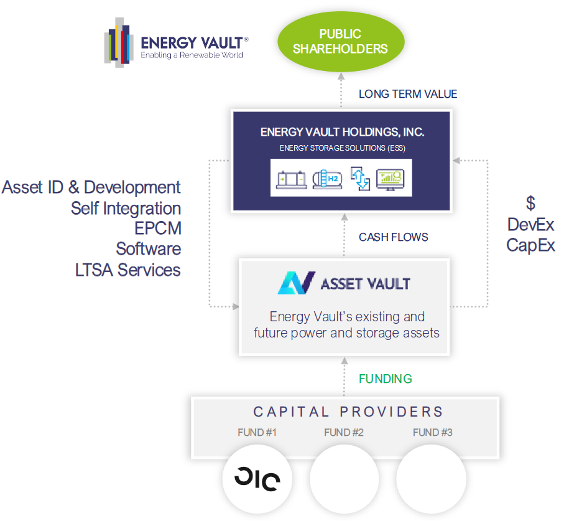
Source: Company
NRGV is transitioning to an IPP, shifting primary revenue to long-term energy and power sales agreements (“tolling agreements”)
Products and Solutions
Energy Vault offers both legacy and modern energy storage solutions, combining proprietary gravity, battery, and green hydrogen technologies with a hardware-agnostic software platform. Its integrated suite of storage solutions enables customized short-, long-, and ultra-long-duration applications, enhancing grid stability, efficiency, and reliability. Stored energy can be dispatched on-demand, providing backup capacity for renewable and fossil fuel sources alike.
NRGV combines proprietary hardware and software with off-the-shelf components to deliver energy storage solutions tailored to project scale, location, and grid needs
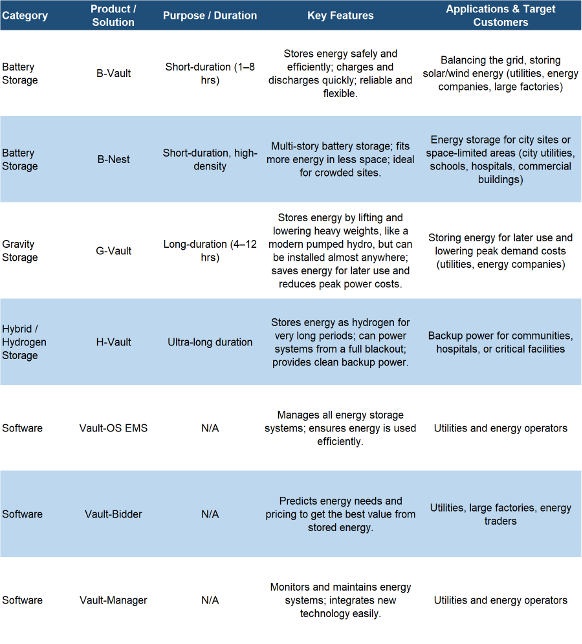
Source: FRC / Company
While the company offers multiple technologies, its B-Vault lithium-ion system has driven most of its revenue
B-Vault integrates standard lithium-ion cells with NRGV’s proprietary controls and software
We believe NRGV’s competitive edge comes from integrating multiple storage technologies with proprietary software, and strong project sourcing and execution capabilities
St. Gall BESS, Texas: Battery storage for grid applications
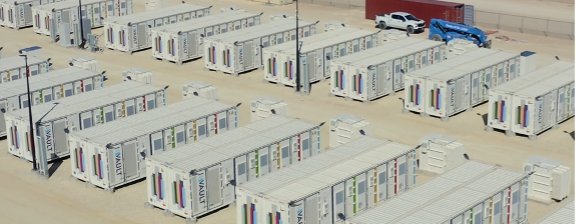
NRGV deploys both hybrid and standalone solutions across different geographies
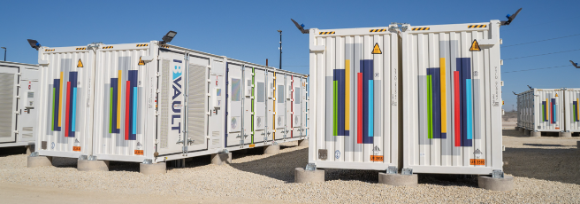
Grid operators and large energy consumers rely on energy storage to smooth fluctuations, provide backup power, optimize energy efficiency, and integrate intermittent renewables for reliable power delivery
Calistoga Resiliency Center

Source: Company
A Vertically Integrated Full Stack Solution
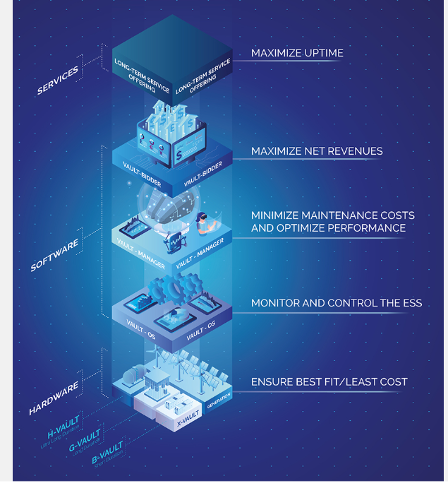
Source: Company
The diagram illustrates NRGV’s complete ecosystem, integrating proprietary hardware (B-Vault, G-Vault, H-Vault), with a multi-layered software platform
46 U.S. patents/pending, 192 international patents/pending
Competition - Energy Vault operates in a highly competitive energy storage market, but we believe it stands out as one of the few companies able to deploy a broad range of storage technologies, tailored to duration and capacity. This flexibility allows NRGV to provide solutions for short- and long-duration applications, offering optimized performance and extended lifespan. Key challenges include being a relatively new entrant competing against well-established companies with greater resources and recognition.
With NRGV’s recent shift toward owning projects, we believe competition is less of a concern

Source: FRC
Projects – Asset Vault & Third-Party
Energy Vault projects span the U.S., Australia, China, and Europe, demonstrating the company’s ability to deploy diverse storage technologies across multiple markets
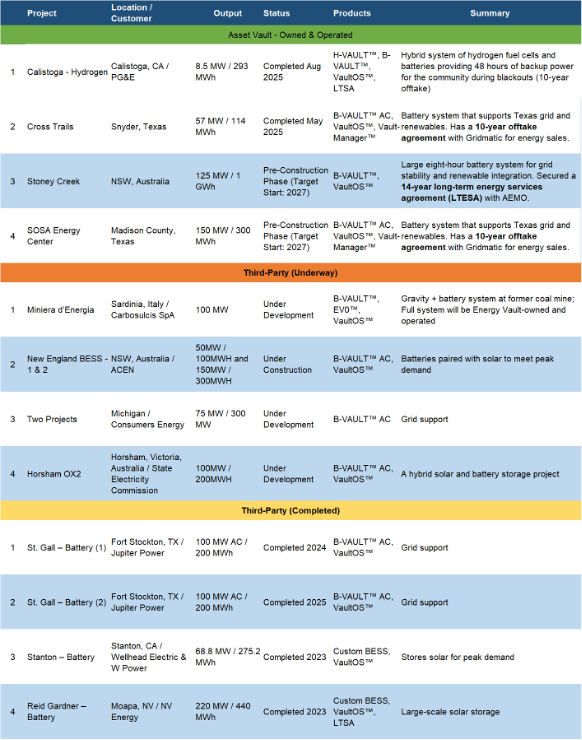
Source: Company / FRC
Six projects completed to date, covering both owned & operated (two) and third-party deployments (four)
Seven projects currently under development or construction, including two owned & operated and five third-party, with three located in the U.S., and four in Australia
Projects include battery systems, gravity-based, hybrid, hydrogen, and nuclear, designed to provide multi-hour energy storage and grid support
Most projects have offtake agreements, ensuring predictable revenue streams and partnerships with utilities and energy developers
The company is transferring its 100% owned assets, including two operating U.S. projects and two in development (U.S. and Australia), into the Asset Vault platform.
Operating Projects
(Combined deployed capital: ~$100M; expected to generate $10M in annual EBITDA)
- Cross Trails BESS: 57 MW / 114 MWh, completed May 2025, backed by a 10-year offtake agreement
- Calistoga Resiliency Center: 8.5 MW / 293 MWh, hybrid hydrogen + battery, completed August 2025, backed by a 10-year offtake agreement
NRGV has deployed 1.4 GWh of storage capacity ($551M revenue), with 2.4 GWh in contracted backlog and 5.9 GWh in pipeline
Development Projects:
- Stoney Creek BESS (125 MW / 1.0 GWh, Australia): Acquired for $2.6M, backed by a 14-year offtake agreement; expected to generate $20M in annual EBITDA
- SOSA Texas Development Project (150 MW / 300 MWh): Acquired from Shell (LSE: SHEL), construction starts Q4-2025, commercial operation Q1-2027; eight year offtake agreement; expected to generate $10M in annual EBITDA
Backlog projects total $950M in potential revenue, including about one-third from five third-party deployment projects (to be recognized in 2025–2026), and the remaining from tolling revenue tied to three company-owned projects under 10-14 year offtake agreements
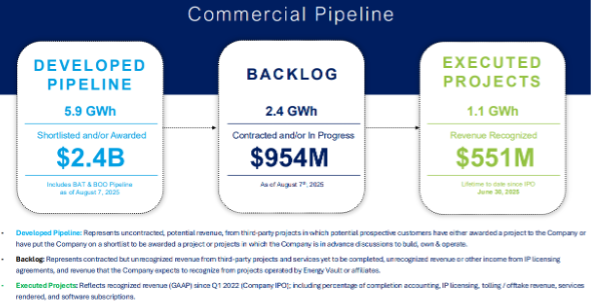
* Total executed projects stand at 1.5 GWh as of this report

Source: Company
Given that the typical asset life of such facilities is around 20 years, these offtake agreements could be extended for another six to 10 years
Project Development, Permitting, Tax Credits, and Timelines
NRGV’s sales cycle can extend months to years, involving negotiations, financial structuring, and regulatory approvals. Construction typically spans 12–24 months, depending on complexity and location. Permitting timelines vary by jurisdiction and may be affected by local zoning, environmental assessments, and community engagement. Batteries, components, and power systems are procured, primarily from China and other suppliers, and integrated via contractors, with NRGV overseeing construction and installation.
Batteries and components sourced globally, installed via contractors under NRGV oversight
A major advantage of renewable energy storage projects is eligibility for tax credits and government incentives. In the U.S., the Investment Tax Credit (ITC) allows owners to claim 30%-40% of project costs as a tax credit, enabling NRGV to attract tax equity investors and secure upfront capital for development. Under the $1B Asset Vault CAPEX plan, we note that roughly $300M could be financed through ITC monetization.
U.S. ITC allows 30%-40% of project costs to be claimed, enabling upfront financing through tax equity
Revenue Model
NRGV operates under two main models:
- Third-Party Projects: Revenue is primarily one-time and project-based, coming from product sales and installations, typically paid in stages as projects are completed. Customers include utilities, independent power producers, and large industrial operators. Gross margins are relatively low (~15%), though there is potential for additional long-term revenue if customers opt for maintenance, support, or software services.
- Owned & Operate Projects (Asset Vault): NRGV builds and operates storage assets. These projects are typically deployed at strategic grid locations, often near renewable and intermittent generation, where NRGV’s systems draw electricity from the grid when supply is abundant or prices are low and discharge when demand is high. Electricity is sold to utilities and grid operators under long-term contracts, providing stable, predictable revenue. While NRGV assumes some pricing risk, it is limited because offtake agreements are generally fixed-price or include a revenue floor, ensuring a minimum guaranteed payment even if some stored energy is unused. Gross margins are high (~80%) because operating costs are minimal once the systems are installed.
Low-margin third-party vs high-margin recurring Asset Vault revenue
Growth Strategy & Funding
Asset Vault targets 15%+ IRR, and $1B deployment across 1.5 GW, funded by OIC, equity, debt, and ITC
- The Asset Vault platform targets projects with long-term revenue contracts and ITC incentives, aiming for 15%+ levered IRRs over a 20-year asset life.
- Note that NRGV does not generate energy; it stores electricity from the grid when prices are low, and discharges it when prices are high.
- NRGV is transferring its 100% owned assets into the platform. Over the next four years, Asset Vault plans to invest $1B in CAPEX across projects totaling 1.5 GW in the U.S., Australia, and Europe. Funding Sources:
- $300M from Orion Infrastructure Capital (OIC)
- $75M from NRGV
- $625M through debt financing and other sources; for U.S. projects, approximately 50% of this can be financed via ITC monetization
Asset Vault Structure & Economics
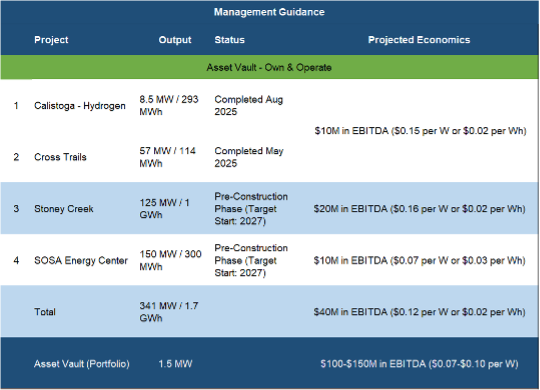
*CAPEX to build a system is ~$0.30/Wh in the U.S. and ~$0.20/Wh outside the U.S., assuming a two-three hour duration
Source: Company / FRC
Asset Vault aims for $100-$150M annual recurring EBITDA within four years across 1.5 GW, or $0.07-$0.10/W; the four current projects (341 MW) target $40M EBITDA, or $0.12/W
Project economics depend on storage duration; longer-duration projects earn more EBITDA per MW (e.g., Sosa: two-hour → $0.07/W, Stoney Creek: eight-hour → $0.16/W)
• Asset Vault is 100% owned by NRGV but managed as a separate entity.
• Orion Infrastructure Capital (OIC) holds preferred shares with no voting rights or equity.
• OIC will receive the greater of:
o A 1.65x multiple on invested capital, or
o A 12% IRR upon liquidation.
• 4:1 split commitment: OIC contributes $4 for every $1 from NRGV, therefore, $300M from OIC requires $75M from NRGV.
• OIC receives quarterly distributions, but cash distributions only start after three years.
• In the first three years, interest accrues as Payment-in-Kind (PIK) — interest paid in additional debt instead of cash.
• Redemption occurs in six years, with an early redemption option for NRGV.
- CAPEX & Installations: Of the $1B planned CAPEX, NRGV will handle installations, earning ~15% gross margin, or ~$150M
- Proposed Deployment of $1B:
• Stoney Creek BESS (Australia) - development project – $220M
• SOSA Energy Center (Texas) - development project – $125M
• Calistoga Resiliency Center (California) & Cross Trails BESS (Texas) - $40M
• Other projects – $610M
Tolling Revenue: Projected at $100-$150M EBITDA. Assuming OIC receives a 12% return ($36M), NRGV retains $64-$114M in annual operating profit, before interest payments on debt, over a potential 20-year asset

Source: Company
Other Initiatives
- Crusoe Partnership - In October 2025, NRGV signed an agreement with Crusoe to supply energy storage hardware and software for its AI data centers. Crusoe, an AI infrastructure provider, recently raised $1.4 B at a $10 B valuation. Financial details were not disclosed. We believe the collaboration is a testament to NRGV’s technological expertise and presents a potential long-term revenue opportunity.
- Minority Investments - In addition to owning projects outright, NRGV’s “Flex-IPP” model involves taking minority interests in third-party projects. Under this structure, NRGV earns installation and deployment revenue while retaining a minority stake in the projects’ long-term cash flows.
Management and Directors
Share Ownership
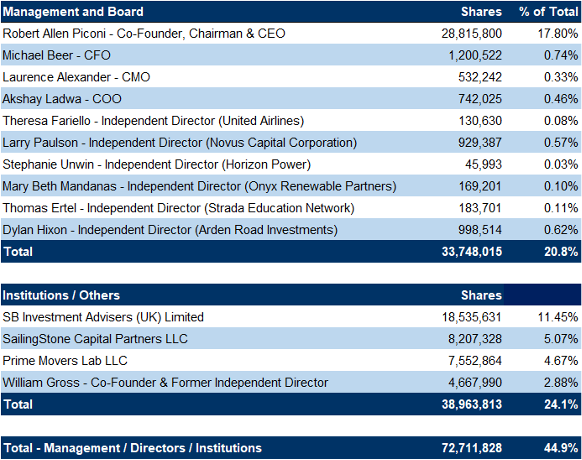
Source: Edgar / FRC
Management and board own 21%
Six out of seven directors are independent
Brief biographies of the management team and board members, as provided by the company, follow:
Robert Piconi – Co-Founder, Chairman & CEO
Robert’s experience includes prior executive leadership roles in Fortune 100 public companies across various industries including Diversified Energy (Amoco/British Petroleum), Telecommunications (Bell Labs, Lucent Technologies, Alcatel), and Security/Network Management Software (Danaher Corporation). He also founded and managed several innovative healthcare service and diagnostic imaging companies within the European market which were later acquired by private equity funds and/or large industry conglomerates. In 2020, Mr. Piconi was one of 15 global leaders named by the World Economic Forum as “SDG Champion” for his work advancing sustainability, decarbonization and the circular economy. Mr. Piconi received a Master’s degree from Northwestern University (Kellogg School of Management) and undergraduate BS/BBA degrees from the University of Notre Dame.
Michael Beer – CFO & Head of Corporate Services
Michael also currently serves on the Board of Directors at UK-based venture builder, Cambridge Future Tech (CFT) and is a Partner at Vest Coast Capital. Prior to Energy Vault, Michael served as CFO of FreeWire Technologies and Head of Financial Strategy & Investor Relations at Luminar Technologies (NASDAQ: LAZR). Before Luminar, Michael spent seven years at Citi (NYSE:C) in Hong Kong & Singapore, overseeing the transportation, logistics and infrastructure research franchise across Asia. From 2006-2008, he covered the North American transportation sector at Bear Stearns in New York. Michael has been a frequent contributor to CNBC, Nasdaq TradeTalks, Wall Street Journal, Financial Times and Barron's, among others. Michael completed his MBA at the Wharton School.
Laurence Alexander – CMO & Chief of Staff
Mr. Alexander has served as Chairman for Wantley Manor Consultancy Ltd. since 2002 and a board advisor for Chronos Imaging LLC since 2018. Prior to Energy Vault, Mr. Alexander co-founded EarlyWMC Limited and served as its Chairman from 2010 to 2019. Mr. Alexander also served as VP, Marketing for Danaher Corporation from 2010 to 2015, Group Chief Executive Officer for SAB Holdings from 2009 to 2010, held various positions at O2, a brand owned by Telefónica, from 2002 to 2005, served as CEO for Genie, a subsidiary of British Telecom, from 1999 to 2002, and as MD of Consumer Services and COO for World Online from 1998 to 1999. Mr. Alexander holds a HND in Business Studies from Greater Brighton MET.
Akshay Ladwa - Chief Development and Operations Officer
Akshay’s experience includes executive management roles in Energy Storage, Integration, project management and Engineering (BrightNight, Wärtsilä, and Greensmith), Mechanical Systems Engineer (GE Energy Storage), and PV System Design and Development Engineer (Solar). Akshay holds a Masters of Science in Mechanical Engineering from Laurence Technological University, and a Bachelors of Science degree in Mechanical Engineering from Visvesvaraya Technological University
Marco Terruzzin, Ph.D. - Chief Revenue Officer
Prior to Energy Vault, Dr. Terruzzin served as Director of Energy Storage for RWE Renewables from 2017 to 2019. Prior to joining RWE Renewables, Dr. Terruzzin served as Head of Energy Storage Edge Platform for Stem from 2016 to 2017. Prior to joining Stem, Dr. Terruzzin served as Managing Director — Americas for NOHA (former Engie EPS) from 2015 to 2016. Prior to NOHA, Dr. Terruzzin was Managing Director APAC for Evolutions Markets, based in Beijing. Dr. Terruzzin holds an M.Sc. in Mechanical Engineering and a Ph.D. in Energy Economics from University of Padua (Italy) and an M.B.A. from the University of Virginia Darden School of Business.
Energy Storage Market Overview
The utility-scale energy storage market is expanding rapidly as global electricity demand grows, renewable energy adoption accelerates, and grid resilience becomes increasingly important. Deployment of wind, solar, and other renewable resources has surged in the past decade and is expected to continue growing, driving the need for storage solutions to manage the intermittency of these variable energy sources and maintain a balanced, reliable grid.
Key demand drivers at the utility scale include the rapid growth of AI data centers, increasing renewable integration, and rising grid reliability requirements. Government mandates and corporate initiatives aimed at reducing costs, emissions, and energy use further accelerate the shift toward renewables and large-scale energy storage.
Share of renewable electricity generation by technology

Global renewable electricity generation is projected to exceed 17,000 terawatt-hours (TWh) by the end of this decade, a 90% increase from 2023
Global battery storage capacity additions

Source: IEA
The share of renewables in total electricity generation is expected to rise from the current 35% to over 46% by 2030

Global energy storage capacity additions grew from nearly zero in 2010 to 70 GW by 2024, with rapid acceleration in recent years, and are projected to reach 220 GW by 2035, a CAGR of 15% between 2025 and 2035
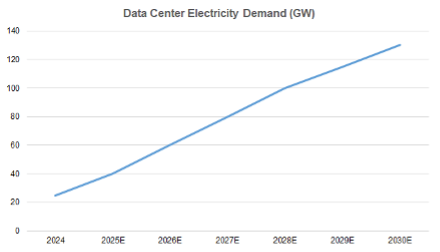
Source: U.S. DOE / Lawrence Berkeley National Lab
Electricity demand from AI data centers in the U.S. is expected to triple by 2030

Governments worldwide are driving renewable energy through tax incentives, funding programs, and large-scale deployment policies, e.g., US ITC/PTC, EU Green Deal, India’s National Solar Mission, and China’s feed-in tariffs
Green bonds, carbon pricing, and climate funds, further accelerate clean energy adoption globally
Major Investments in Energy Storage Projects for Data Centers
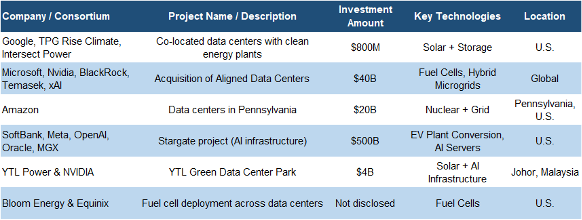
Source: FRC / Various
Majors are heavily investing in energy storage to ensure reliable, low-carbon power for data centers
In summary, the sector outlook is very positive, driven by surging demand from data centers, AI applications, and industrial electrification, supported by declining storage costs, advanced software, and policy incentives.
Financials

Historically, revenue has been lumpy and tied to project milestones. In H1 2025, three clients accounted for 86% of revenue, while two clients represented 94% of 2024 revenue

H1-2025 revenue was up 48% YoY
As a result, margins, EBITDA, and free cash flows improved
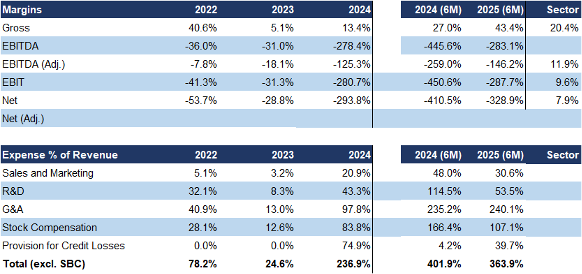
Source: FRC / Company
EPS was down, mainly due to non-recurring items, including reduced interest income from treasury cash

At the end of Q2, the company had $54M in cash, and $33M in debt
Subsequent to Q2, NRGV secured a $50M debenture financing


In-the-money options can bring in $10M
FRC Valuation and Rating

Our 2025–2026 projections are primarily driven by the project backlog from third-party deployments
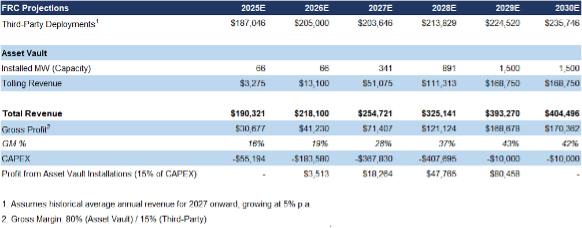
Source: FRC
We expect ongoing project acquisitions for Asset Vault, scaling total capacity to 1.5 GW by 2029
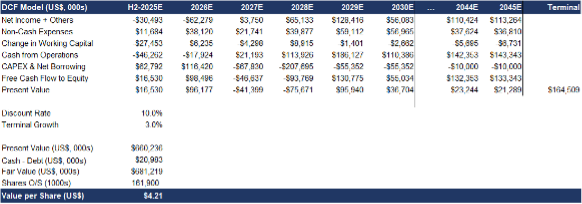
Source: FRC
Our DCF valuation returned a fair value estimate of $4.21/share

*We use the present value of our 2029 EBITDA estimate for NRGV in this calculation.
Source: FRC / S&P Capital IQ
NRGV is trading at 12x forward EBITDA vs the sector average of 16x; applying the sector multiple yields a comparables valuation of $5.53/share
We are initiating coverage with a BUY rating, and a fair value estimate of $4.87/share (the average of our DCF and comparables valuations). We believe NRGV is well-positioned in the growing grid-scale energy storage market, driven by rising power demand, renewable integration, and regulatory support. Its shift to an IPP model with the Asset Vault platform, provides visibility to recurring revenue and long-term EBITDA growth. Trading at a 24% discount to the sector on forward EBITDA, we believe NRGV offers near-term upside potential from its project backlog and upcoming Q3 results.
Risks
We believe the company is exposed to the following key risks (not exhaustive):
- Tariffs: U.S. tariffs on Chinese lithium-ion imports may raise costs
- Policy: Changes in green energy incentives could reduce demand
- Credit: Customer or partner defaults may affect revenue
- Compliance: Projects must meet all regulations and permits
- Financing: High upfront costs require funding
- Sales Cycle: Long nine-to-18-month installation delays revenue
- FOREX
While the company operates in a relatively low-risk market with potential for long-term steady cash flow, we believe its early-stage deployment warrants a risk rating of 4 (Speculative




































